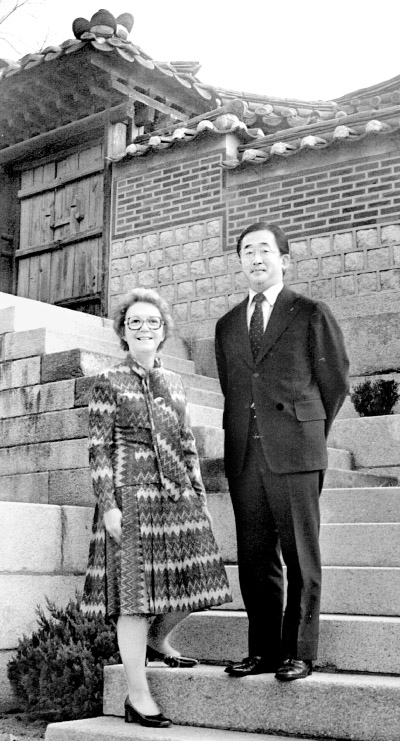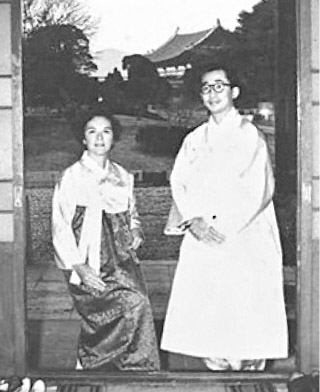Mullock, ‘last princess’ of Korea, dies at 94

The “Last Crown Prince” of the Korean Empire, Yi Gu, right, and his wife, Julia Mullock, in the 1970s in front of Nakseon Hall of Changdeok Palace in central Seoul, where they lived. [JOONGANG PHOTO]
“Moving was so difficult she couldn’t even use a mobile phone, and so she just shut her eyes,” said Lee Nam-ju, a former music professor at Sungshin Women’s University and a distant relative of Yi Gu.
From 1958 to 1982, Mullock was married to the late Yi Gu (1931-2005), son of the last crown prince of Korea, Yeongchin, and pretender to the Korean Imperial Throne from 1970 until his death.
Mullock, an American, died a lonely death of old age at the Hale Nani Rehabilitation and Nursing Center.

The Yi couple, wearing hanbok (Korean traditional clothing), at Nakseon Hall in 1963. [JOONGANG PHOTO]
“Yi, who wandered around lonely in a foreign country,” Lee said, “would have relied on Julia, who was eight years his senior, like a mother or sister.”
Yi’s father and mother, who were then living in Japan, requested that the couple return with them to Korea in 1963. And so they moved into Nakseon Hall at Changdeok Palace in central Seoul.
While Mullock was talented and affectionate, she found it difficult to adjust to the unfamiliar palace life.
The imperial family was not accepting of a blue-eyed, foreign “princess” and pressured Yi to divorce her, noting that she had yet to produce an heir.
Mullock, who eventually began living separately from her husband in a hotel because she did not like Nakseon Hall, finally stamped the divorce papers in 1982.
“While there had been discord with her mother-in-law, Yi Bangja,” Lee said, “she had done her best to do her duty as the last female of the Joseon royal family.”
For example, she was said to have operated a sewing room at Nakseon Hall, hiring and training people with disabilities who were affiliated with Crown Princess Yi Bangja’s social welfare foundation.
The workers who were trained under her called her “Keun Umma,” or “Big Mother,” which also means “aunt” in Korean, and even after her divorce from Yi, she maintained her relationship with them long after, continued her welfare projects and ran a boutique called “Julia Shop.” Working alone for the next dozen years, Mullock eventually moved to Hawaii in 1995.
During her time at Nakseon Hall, she and Yi adopted a daughter, Eugenia Unsuk Lee. Lee Nam-ju said Mullock never remarried and longed for her former husband, from whom she had not heard news since their divorce, when he left for Japan.
In September 2000, Mullock returned to Korea for a month, revisiting familiar places. She paid respect at her father-in-law’s tomb, stopped by Nakseon Hall and also met her old disciples.
She donated some relics of the Joseon Dynasty and 450 photographs related to Korean modern history to the National Museum of Contemporary Art at Deoksu Palace, which was captured in a documentary entitled “Julia’s Last Letter.”
But despite longing to see Yi, she was never reunited with her former husband.
Yi Gu was found dead on July 16, 2005, in Tokyo at the then Akasaka Prince Hotel, which had formerly been the Kitashirakawa Palace, his birthplace. His body was returned to Korea on July 20 that year, where the funeral was held. Mullock was not invited.
She was only able to watch Yi’s funeral procession from afar, as it passed by Nakseon Hall and Jongmyo Shrine in central Seoul, to its final burial site.
In October of last year, Lee Nam-ju visited Mullock at the Hale Nani Rehabilitation and Nursing Center in Hawaii. “I still remember vividly,” he said, “at first, she stared at me blankly. And then she mumbled, ‘This is a miracle,’ and wept endlessly.”
Her love for one man had carried her to a far-off country and forever changed the course of her life, which has now gone out like the last flicker of an empire, the Korean Empire (1897-1910), which faded over a century ago.
BY JUNG JAE-SOOK, SARAH KIM [kim.sarah@joongang.co.kr]










with the Korea JoongAng Daily
To write comments, please log in to one of the accounts.
Standards Board Policy (0/250자)